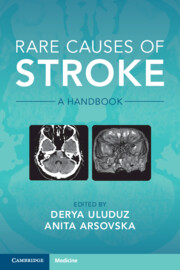Book contents
- Rare Causes of Stroke
- Rare Causes of Stroke
- Copyright page
- Contents
- Contributors
- Preface
- 1 Inflammatory Conditions
- 2 Infectious and Postinfectious Vasculitis
- 3 Hypercoagulable Causes of Stroke
- 4 Drug-Related Stroke
- 5 Hereditary and Genetic Causes of Stroke
- Chapter 5.1 Genetic Collagen Disorders
- Chapter 5.1 Chapter
- Chapter 5.2 Genetic Small-Vessel Diseases
- Chapter 5.3 Genetic Metabolic Diseases
- 6 Rare Causes of Cardioembolism
- 7 Vasospastic Conditions and Other Vasculopathies
- 8 Other Non-inflammatory Vasculopathies
- 9 Venous Occlusive Conditions
- 10 Bone Disorders and Stroke
- Index
- References
Chapter 5.1 - Chapter
from 5 - Hereditary and Genetic Causes of Stroke
Published online by Cambridge University Press: 06 October 2022
- Rare Causes of Stroke
- Rare Causes of Stroke
- Copyright page
- Contents
- Contributors
- Preface
- 1 Inflammatory Conditions
- 2 Infectious and Postinfectious Vasculitis
- 3 Hypercoagulable Causes of Stroke
- 4 Drug-Related Stroke
- 5 Hereditary and Genetic Causes of Stroke
- Chapter 5.1 Genetic Collagen Disorders
- Chapter 5.1 Chapter
- Chapter 5.2 Genetic Small-Vessel Diseases
- Chapter 5.3 Genetic Metabolic Diseases
- 6 Rare Causes of Cardioembolism
- 7 Vasospastic Conditions and Other Vasculopathies
- 8 Other Non-inflammatory Vasculopathies
- 9 Venous Occlusive Conditions
- 10 Bone Disorders and Stroke
- Index
- References
Summary
Marfan syndrome is a genetically inherited systemic disease of connective tissue, usually characterized by skeletal, cardiovascular and ocular involvement. We present a 44 years-old male, with heart valve and lens subluxation surgery, presented to the outpatient clinic with complaint of weakness on the left side. He was receiving anticoagulant treatment. His parents were second-degree relatives, and his 16-years-old son had aortic valve regurgitation and lens subluxation. The patient was extremely tall and thin with typical musculoskeletal features of Marfan syndrome. These included pectus excavatus deformity, ulnar deviation in both hands, as well as swan neck deformity, long fingers, joint hypermobility, and right-sided scoliosis. Neurological examination revealed irregular pupil on the right, left-sided hemiparesis, hyperreflexia, and piramidal signs on the left side. Brain magnetic resonance imaging showed infarction in the temporo-parietal region of the right hemisphere
Keywords
- Type
- Chapter
- Information
- Rare Causes of StrokeA Handbook, pp. 206 - 211Publisher: Cambridge University PressPrint publication year: 2022



